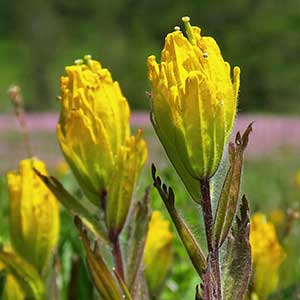Castilleja glandulifera
Castilleja levisecta
gland Indian paintbrush, glandular paintbrush, sticky paintbrush
golden Indian paintbrush, golden paintbrush
few to many, erect or ascending, sometimes decumbent, unbranched or often branched proximally, hairs spreading, medium length and long, soft, mixed with more abundant stipitate-glandular ones.
few to many, erect, ± decumbent or creeping at base, unbranched, sometimes branched, hairs spreading, medium length and long, soft, mixed with short stipitate-glandular ones.
green, linear-lanceolate to sometimes narrowly oblong or narrowly oblanceolate, 0.7–3.7 cm, not fleshy, margins wavy, involute, 0(–5)-lobed, apex acute;
lateral lobes ascending to erect, narrowly lanceolate to narrowly oblong, usually narrower than center lobe, apex acute.
green to purple or brown-tinged, linear-lanceolate proximally, oblong-ovate or -obovate distally, 0.8–5.2 cm, not fleshy, margins plane, distalmost sometimes ± wavy, involute, 3–7(–11)-lobed, apex obtuse;
lobes erect to ascending, linear to linear-spatulate, very short, toothlike, usually arising from distal 1/3 of blade, apex rounded.
2.5–10 × 2–5 cm;
bracts proximally pale green to pale yellow, distally yellow, whitish, pink, dull red, or purple on apices (sometimes gradually differentiated from proximal coloration), lanceolate, broadly lanceolate, or oblong, 3–5(–7)-lobed, sometimes with secondary lobes;
lobes ascending to spreading, linear, sometimes rounded, medium length or distal short, arising near mid length, apex acute to rarely obtuse.
2.5–25 × 1–4 cm;
bracts bright yellow throughout, or proximally greenish, distally bright yellow, sometimes deep yellow-orange, especially with age, oblong, elliptic, or obtuse to ovate, (0–)5–9(–13)-lobed, sometimes wavy-margined;
lobes erect to ascending, oblong, short to medium length, arising above mid length, central lobe apex rounded, lateral ones rounded to acute.
straight or slightly curved, (20–)22–30 mm;
tube 15 mm;
abaxial lip usually hidden or just visible in abaxial calyx notch, not exserted/longer than calyx, beak exserted;
beak straight or slightly curved, adaxially green, 8–11(–12) mm;
abaxial lip deep green to yellow, reduced, slightly pouched, 1–2.5 mm, to 20% as long as beak;
teeth incurved, green to yellow, 0.5–1 mm.
straight or slightly curved, 17–28 mm;
tube 12–15 mm;
beak exserted, adaxially green or greenish yellow, 6–8 mm;
abaxial lip yellow or greenish, reduced, not inflated, 2–3 mm, 25–33(–50)% as long as beak;
teeth ascending to erect, yellow, 0.5–1.5 mm.
proximally green or pale, distally colored as bracts, 17–21(–23) mm;
abaxial and adaxial clefts 4–8 mm, 33–50% of calyx length, deeper than laterals, lateral 2–6 mm, 15–33% of calyx length;
lobes linear, narrowly lanceolate, or narrowly triangular to oblong, apex acute.
distally yellow, 13–22 mm;
abaxial and adaxial clefts 4–9.5 mm, 30–40% of calyx length, deeper than laterals, lateral 2.5–4.5 mm, ca. 25% of calyx length;
lobes linear to narrowly oblong or narrowly lanceolate, apex obtuse, sometimes rounded to acute.
= 24.
Castilleja glandulifera
Castilleja levisecta
Castilleja glandulifera is endemic to the upper elevations of the Blue and Strawberry mountains of northeastern Oregon, as well as a few adjacent minor ranges. It is related to C. applegatei and C. viscidula, which are the source of reports of C. glandulifera in the Wallowa Mountains and on Steens Mountain. Inflorescences of C. glandulifera are usually white to pale yellow, but in the area around Marble Creek Pass in Baker County, they are multicolored, with a variety of reddish shades mixed in among the yellowish plants. Castilleja glandulifera and C. viscidula share a glandular pubescence, divided leaves, and usually yellowish inflorescences. Castilleja glandulifera is distinguished from C. viscidula by its taller stature, longer corolla beak, and more deeply divided leaves and bracts with linear to linear-lanceolate lobes. Castilleja glandulifera differs from C. applegatei by its unusual leaves and bracts as well as by its habitat and narrower and somewhat shorter corolla beak.
(Discussion copyrighted by Flora of North America; reprinted with permission.)
Castilleja levisecta is listed as threatened in the United States and endangered in Canada, where it is extremely rare. Most of its grassland habitat has been altered by development in the Puget Trough, and there are historical stations in the metro areas of what are now Victoria, Portland, and Seattle. For several decades, C. levisecta was considered extirpated from Oregon. However, recent reintroduction programs in Oregon and Washington have been very successful at reestablishing this species at several sites in the Willamette Valley. The bright yellow inflorescences often gradually age to a golden yellow color, unique in the genus.
Castilleja levisecta is in the Center for Plant Conservation’s National Collection of Endangered Plants.
(Discussion copyrighted by Flora of North America; reprinted with permission.)


